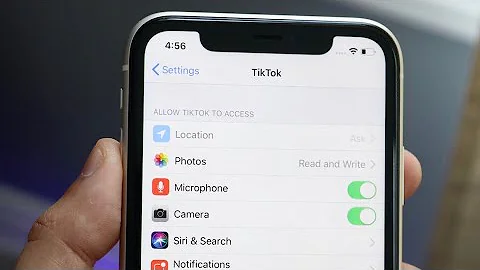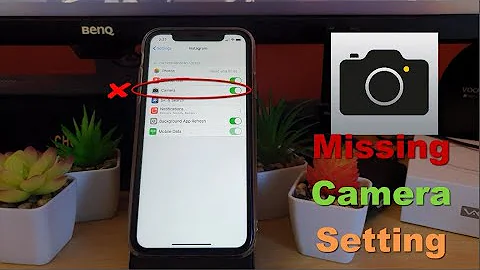Detect permission of camera in iOS
Solution 1
Check the AVAuthorizationStatus and handle the cases properly.
NSString *mediaType = AVMediaTypeVideo;
AVAuthorizationStatus authStatus = [AVCaptureDevice authorizationStatusForMediaType:mediaType];
if(authStatus == AVAuthorizationStatusAuthorized) {
// do your logic
} else if(authStatus == AVAuthorizationStatusDenied){
// denied
} else if(authStatus == AVAuthorizationStatusRestricted){
// restricted, normally won't happen
} else if(authStatus == AVAuthorizationStatusNotDetermined){
// not determined?!
[AVCaptureDevice requestAccessForMediaType:mediaType completionHandler:^(BOOL granted) {
if(granted){
NSLog(@"Granted access to %@", mediaType);
} else {
NSLog(@"Not granted access to %@", mediaType);
}
}];
} else {
// impossible, unknown authorization status
}
Solution 2
Swift 4 and newer
Make sure to:
import AVFoundation
The code below checks for all possible permission states:
let cameraMediaType = AVMediaType.video
let cameraAuthorizationStatus = AVCaptureDevice.authorizationStatus(for: cameraMediaType)
switch cameraAuthorizationStatus {
case .denied: break
case .authorized: break
case .restricted: break
case .notDetermined:
// Prompting user for the permission to use the camera.
AVCaptureDevice.requestAccess(for: cameraMediaType) { granted in
if granted {
print("Granted access to \(cameraMediaType)")
} else {
print("Denied access to \(cameraMediaType)")
}
}
}
Since iOS 10 you need to specify
NSCameraUsageDescription key in your Info.plist to be able ask for camera access, otherwise your app will crash at runtime. See APIs Requiring Usage Descriptions.
An interesting sidenote from Apple Developer forum:
The system actually kills your app if the user toggles your app's access to camera in Settings. The same applies to any protected dataclass in the Settings→Privacy section.
Solution 3
Swift Solution
extension AVCaptureDevice {
enum AuthorizationStatus {
case justDenied
case alreadyDenied
case restricted
case justAuthorized
case alreadyAuthorized
case unknown
}
class func authorizeVideo(completion: ((AuthorizationStatus) -> Void)?) {
AVCaptureDevice.authorize(mediaType: AVMediaType.video, completion: completion)
}
class func authorizeAudio(completion: ((AuthorizationStatus) -> Void)?) {
AVCaptureDevice.authorize(mediaType: AVMediaType.audio, completion: completion)
}
private class func authorize(mediaType: AVMediaType, completion: ((AuthorizationStatus) -> Void)?) {
let status = AVCaptureDevice.authorizationStatus(for: mediaType)
switch status {
case .authorized:
completion?(.alreadyAuthorized)
case .denied:
completion?(.alreadyDenied)
case .restricted:
completion?(.restricted)
case .notDetermined:
AVCaptureDevice.requestAccess(for: mediaType, completionHandler: { (granted) in
DispatchQueue.main.async {
if granted {
completion?(.justAuthorized)
} else {
completion?(.justDenied)
}
}
})
@unknown default:
completion?(.unknown)
}
}
}
And then in order to use it you do
AVCaptureDevice.authorizeVideo(completion: { (status) in
//Your work here
})
Solution 4
As an addition to the answer from @Raptor the following should be mentioned. You may receive the following error starting with iOS 10: This application is modifying the autolayout engine from a background thread after the engine was accessed from the main thread. This can lead to engine corruption and weird crashes.
To fix this, make sure you handle the results from the main thread as follows (Swift 3):
private func showCameraPermissionPopup() {
let cameraMediaType = AVMediaTypeVideo
let cameraAuthorizationStatus = AVCaptureDevice.authorizationStatus(forMediaType: cameraMediaType)
switch cameraAuthorizationStatus {
case .denied:
NSLog("cameraAuthorizationStatus=denied")
break
case .authorized:
NSLog("cameraAuthorizationStatus=authorized")
break
case .restricted:
NSLog("cameraAuthorizationStatus=restricted")
break
case .notDetermined:
NSLog("cameraAuthorizationStatus=notDetermined")
// Prompting user for the permission to use the camera.
AVCaptureDevice.requestAccess(forMediaType: cameraMediaType) { granted in
DispatchQueue.main.sync {
if granted {
// do something
} else {
// do something else
}
}
}
}
}
Related videos on Youtube
user418751
Updated on September 22, 2021Comments
-
user418751 over 2 years
I am developing a very simple video app. I use the official control: UIImagePickerController.
Here is the problem. When presenting the UIImagePickerController for the first time, the iOS will ask for the permission. The user can click yes or no. If the user clicks no, the control is not dismissed. Instead, if the user keeps clicking the start button, the timers go on while the screen is always black, and the user can't stop the timers or go back. The only thing the user can do is to kill the app. The next time the UIImagePickerController is presented, it is still a black screen and the user can't go back if clicking start.
I was wondering if it's a bug. Is there any way we can detect the permission of the camera so that we can decide to show the UIImagePickerController or not?
-
benc almost 4 yearsRe: is it a bug? IMHO, I think so, because what appears to happen is that the VC is displaying the data from the hardware, but the OS is basically sending dead air. How iOS got here is probably a side effect of the evolution of the product family.
UIImageViewControlleris noted as being added in iOS 2.0, and the docs never annotated to reflect that the AVAuthorizationStatus should be used, but lives in another framework. -
 ch271828n over 3 yearsApple seems to have a official tutorial here: developer.apple.com/documentation/avfoundation/…
ch271828n over 3 yearsApple seems to have a official tutorial here: developer.apple.com/documentation/avfoundation/…
-
-
toblerpwn over 9 yearsalso requires:
#import <AVFoundation/AVFoundation.h>or similar -
 Raptor over 9 yearsYes. Requires to import
Raptor over 9 yearsYes. Requires to importAVFoundation.h. (p.s. the above script is also valid in iOS 8) -
Benjohn over 9 yearsA possibly useful tip – if you are testing code that uses this, you can't merely delete your App from the testing device and then re-instal. Doing this will not cause iOS to reissue the request to the user! What's worked for me though is to change the
Bundle IDof the app each time I want to test this. A pain in the bum, but something, at least. Just remember to set the ID back when you are finished ;-) -
KennyDeriemaeker over 9 years@Benjohn: changing Bundle ID is unnecessary. You can go to Settings > General > Reset and find a setting that will reset all permission prompts on the device. Granted, that's also annoying as it affects all the other apps on your device as well. If only Apple could add apps-specific controls for this in the Development section of Settings.app...
-
Benjohn over 9 years@KennyDeriemaeker :-) Apple might reply that we're supposed to used dedicated devices for testing! For me the side effects of resetting my regular phone would have been pretty sucky. Changing the bundle Id was a reasonably painless alternative. I remembered to change it back before submission too :-)
-
 Canucklesandwich almost 9 yearsJust make sure you don't do a full reset! Simply resetting the Privacy & Location settings (iOS 8) will suffice.
Canucklesandwich almost 9 yearsJust make sure you don't do a full reset! Simply resetting the Privacy & Location settings (iOS 8) will suffice. -
Supertecnoboff over 8 yearsThis is an awesome answer. Can this be used to check if the user has granted photo library access too?
-
 Raptor over 8 years@Supertecnoboff check this out: stackoverflow.com/questions/15004114/…
Raptor over 8 years@Supertecnoboff check this out: stackoverflow.com/questions/15004114/… -
Supertecnoboff over 8 years@Raptor Thanks, but I can't use that. ALAssetsLibrary is deprecated as of iOS 9.
-
Supertecnoboff over 8 years@Raptor No matter, I figured it out using PHPhotoLibrary: stackoverflow.com/a/32989022/1598906
-
 Bill over 7 yearsWhat's with the Info.plist entries? Source?
Bill over 7 yearsWhat's with the Info.plist entries? Source? -
Ethan Allen about 6 yearsIf a user denies camera access and you want to request that they change their permissions to allow it (by taking them directly to Settings) see this: stackoverflow.com/questions/26070393/…
-
 Abdullah Umer about 5 yearsIn case of denied, the requestAccess method will not work. You will have to manually show an alert to ask the user to go to settings and grant permissions.
Abdullah Umer about 5 yearsIn case of denied, the requestAccess method will not work. You will have to manually show an alert to ask the user to go to settings and grant permissions. -
Hajar ELKOUMIKHI about 4 yearsWhat about authorizing camera and photo gallery ??
-
Hajar ELKOUMIKHI about 4 yearsWhat about authorizing camera and photo gallery ??




![How to Add iOS App Camera Access Permission in XCode | Camera Usage Description | [Approved]](https://i.ytimg.com/vi/GAHWt2HPEIM/hq720.jpg?sqp=-oaymwEcCNAFEJQDSFXyq4qpAw4IARUAAIhCGAFwAcABBg==&rs=AOn4CLDmqZmwkT9Oi8yFV4NsrVqTlUiS9g)
